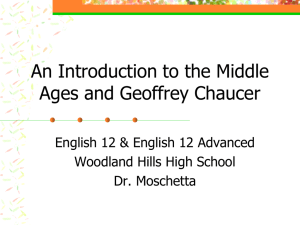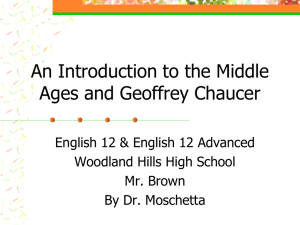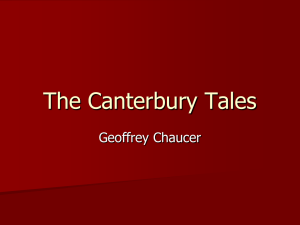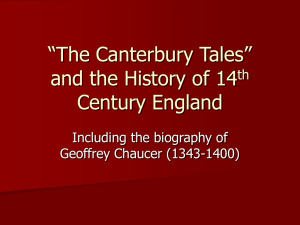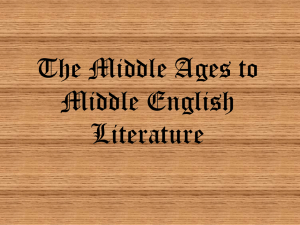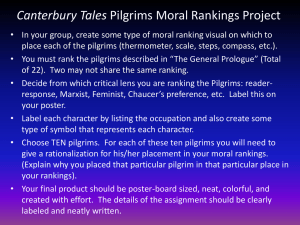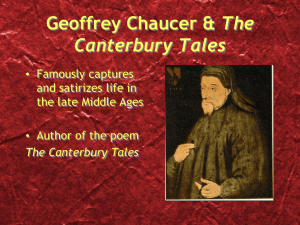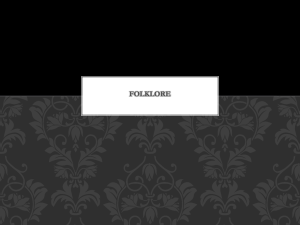Canterbury Tales: Introductory Notes 2
advertisement
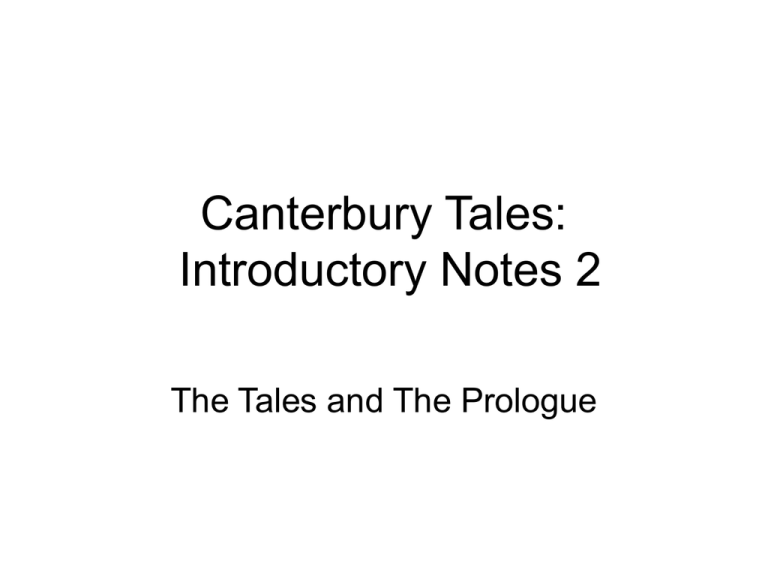
Canterbury Tales: Introductory Notes 2 The Tales and The Prologue The Canterbury Tales (in general) • Chaucer presents the world as he sees it • Began to write it in 1387 (he had written a large number of works prior to this) • Incomplete (Chaucer died in 1400). “The General Prologue” and only 22 tales completed; there were supposed to be 120 total • Shows a cross section of Medieval society The Tales (cont) • It has a frame story of the pilgrimage to Canterbury (80 miles from London) to visit the tomb of the martyr Thomas à Beckett (killed in Canterbury Cathedral in 1170) • pilgrimages to shrines were mass activities in the Middle Ages, partly because they were as likely to be vacations as religious observances Canterbury Location • • • • • • • • http://maps.google.com/maps?hl=en&q=canterbury+england&ie=UTF8&hq=&hnear=Canterbury,+United+Kingdom&gl=us&ei=faijTJ6LFIaKlwf8 95GXBA&ved=0CCgQ8gEwAA&ll=51.45743,0.576782&spn=1.745651,3.147583&z=8 Exterior/overview of cathedral http://www.google.com/imgres?imgurl=http://neatnik2009.files.wordpress.com/2009/10/canterbury-cathedralexterior.jpg%3Fw%3D562%26h%3D385&imgrefurl=http://neatnik2009.wordpress.com/2009/10/06/feast-of-lanfranc-ofcanterbury-may28/&h=385&w=562&sz=146&tbnid=ldlbH4vfwgqGEM:&tbnh=91&tbnw=133&prev=/images%3Fq%3Dcanterbury%2Bcathedral&zo om=1&q=canterbury+cathedral&hl=en&usg=__ObzBhTs7n1HAiNoaWLOknjIQKY=&sa=X&ei=IqmjTL_sKsLflgf3uK3XAw&ved=0CEgQ9QEwBQ Cathedral at night http://www.google.com/imgres?imgurl=http://www.ippnw-students.org/OTT/canterbury.jpg&imgrefurl=http://www.ippnwstudents.org/OTT/route.html&h=768&w=1024&sz=138&tbnid=aerfxFTb_tEdJM:&tbnh=113&tbnw=150&prev=/images%3Fq%3Dc anterbury%2Bcathedral&zoom=1&q=canterbury+cathedral&hl=en&usg=__cw2Bp8qgisYte35tzqakN28XTw=&sa=X&ei=IqmjTL_sKsLflgf3uK3XAw&ved=0CEYQ9QEwBA Images of Pilgrims http://www.google.com/imgres?imgurl=http://english.basd.k12.wi.us/mocarski/englishliterature/Lit1/lydgate.gif&imgrefurl=http://en glish.basd.k12.wi.us/mocarski/englishliterature/Lit1/middleages.html&h=326&w=346&sz=88&tbnid=bmKIth4Pc0aKnM:&tbnh=113 &tbnw=120&prev=/images%3Fq%3Dcanterbury%2Btales&zoom=1&q=canterbury+tales&hl=en&usg=__zlFC7UiF9B7GQ6QSBqr TumTgedk=&sa=X&ei=nKmjTO2RCoX7lwf4hoHjBA&ved=0CEQQ9QEwBA http://www.google.com/imgres?imgurl=http://www.chaucertheatre.org/images/Canterbury_Tales_480.jpg&imgrefurl=http://www.ch aucertheatre.org/html/GCT_Home.html&h=261&w=480&sz=32&tbnid=CeJCwFD8xhXcyM:&tbnh=70&tbnw=129&prev=/images% 3Fq%3Dcanterbury%2Btales&zoom=1&q=canterbury+tales&hl=en&usg=__bVNEVTRQckDevzPXbLSSNDhz0cM=&sa=X&ei=56 ujTNeSJYK8lQe-p6ycBA&ved=0CEcQ9QEwBg The Tales (cont) • 26 pilgrims actually described; 29 referenced. Chaucer is one of the pilgrims for total of 30. • plan was to tell two tales each on the way to Canterbury and two more tales on the way back (30 pilgrims x 4 tales=120 total tales planned) • a tale is often so well fitted to a pilgrim’s character and opinion that the tale and teller illuminate each other • The Tales are distinguished from other similar types of the period because of the realism of the characters; they are more than types. General Information • Tabard Inn (leave from here) • The owner is Harry Bailey (he is the host who established the contest---winner gets a free dinner paid for by other pilgrims) • Harry will be the judge of the best tale • The telling of the tales will help to pass the time more quickly The Writing of the Tales • • • • • • Narrative POV narrator is actually a character (seems to approve) creates multiple levels of irony suspicions that author does not agree with narrator written in iambic pentameter lines rhyme in couplets The Prologue • Opening lines provide a setting and motivation for the Canterbury pilgrimage • Prologue contains all levels of English life • The order of the introduction of each pilgrim is important because it provides the social standing of the different occupations; it begins with the highest social rank and descends in order. The Prologue: Characters • • • • Highest rank is aristocracy or nobility Knight and his household, including Squire (his son) Prioress Monk Friar (should be in lower class but begged so well he is now in the company of nobles) The Prologue: Characters • • • • Commercial Wealthy class Merchant (illegally makes his money from selling French coins) Sergeant of Law (used knowledge of law to buy up foreclosed property) Clerk (good manners, knowledge of books) Franklin (made enough money to be a country gentleman and push for a place of nobility) The Prologue: Characters Guildsmen similar to specialized unions of craftsmen or guilds Haberdasher (makes men’s accessories) Dyer (dyes fabric) Carpenter (works with wood) Weaver (makes fabric) Tapestry-maker (makes rugs/carpets/wall hangings none of them tells a tale The Prologue: Characters • • • • Middle-class group Cook (ranked too high, but he is master of his trade and respected) Shipman (knowledge of and travels in the world) Physician (doctor of medicine[much less revered in Middle Ages than today]) Wife of Bath (included here because of her knowledge and deportment) The Prologue: Characters Virtuous poor or lower class • Parson • Plowman (very poor but represents all of the Christian virtues) The Prologue: Characters • • • • • Immoral lower class Manciple (profits from buying food for the lawyers in the Inns of Court) Miller (vulgar, steals from his customers) Reeve (tells dirty stories and cheats his trusting young master Summoner (corrupt, takes bribes) Pardoner (corrupt: sells fake pardons and fake relics)


